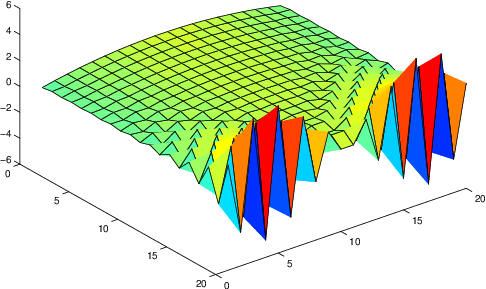CS 5220
Applications of Parallel Computers
Distributed parameter models
Prof David Bindel
Please click the play button below.
Types of PDEs
| Type | Example | Time? | Space dependence? |
|---|---|---|---|
| Elliptic | electrostatics | steady | global |
| Hyperbolic | sound waves | yes | local |
| Parabolic | diffusion | yes | global |
Types of PDEs
Different types involve different communication:
- Global dependence \(\implies\) lots of communication
(or tiny steps) - Local dependence from finite wave speeds;
limits communication
Example: 1D heat equation
Consider flow (e.g. of heat) in a uniform rod
- Heat (\(Q\)) \(\propto\) temperature (\(u\)) \(\times\) mass (\(\rho h\))
- Heat flow \(\propto\) temperature gradient (Fourier’s law)
Example: 1D heat equation
Consider flow (e.g. of heat) in a uniform rod
- Heat (\(Q\)) \(\propto\) temperature (\(u\)) \(\times\) mass (\(\rho h\))
- Heat flow \(\propto\) temperature gradient (Fourier’s law)
\[\begin{aligned} \frac{\partial Q}{\partial t} \propto h \frac{\partial u}{\partial t} &\approx C \left[ \left( \frac{u(x-h)-u(x)}{h} \right) + \left( \frac{u(x)-u(x+h)}{h} \right) \right] \\ \frac{\partial u}{\partial t} &\approx C \left[ \frac{u(x-h)-2u(x)+u(x+h)}{h^2} \right] \rightarrow C \frac{\partial^2 u}{\partial x^2} \end{aligned}\]
Spatial discretization
Heat equation with \(u(0) = u(1) = 0\) \[\frac{\partial u}{\partial t} = C \frac{\partial^2 u}{\partial x^2}\]
Spatial discretization
Spatial semi-discretization: \[\frac{\partial^2 u}{\partial x^2} \approx \frac{u(x-h)-2u(x)+u(x+h)}{h^2}\]
Spatial discretization
Yields a system of ODEs \[\frac{du}{dt} = C h^{-2} (-T) u = -C h^{-2} \begin{bmatrix} 2 & -1 & & & & \\ -1 & 2 & -1 & & & \\ & \ddots & \ddots & \ddots & \\ & & -1 & 2 & -1 \\ & & & -1 & 2 \end{bmatrix} \begin{bmatrix} u_1 \\ u_2 \\ \vdots \\ u_{n-2} \\ u_{n-1} \end{bmatrix}\]
Explicit time stepping
Approximate PDE by ODE system (“method of lines”): \[\frac{du}{dt} = C h^{-2} T u\] Now need a time-stepping scheme for the ODE.
Explicit time stepping
- Simplest scheme is Euler: \[u(t+\delta) \approx u(t) + u'(t) \delta = \left( I - C \frac{\delta}{h^2} T \right) u(t)\]
- Taking a time step \(\equiv\) sparse matvec with \(\left( I - C \frac{\delta}{h^2} T \right)\)
- This may not end well...
Explicit data dependence
Nearest neighbor interactions per step \(\implies\)
finite rate of numerical information propagation
Explicit time stepping in parallel
for t = 1 to N
communicate boundary data ("ghost cell")
take time steps locally
end
Overlapping communication with computation
for t = 1 to N start boundary data sendrecv compute new interior values finish sendrecv compute new boundary values end
Batching time steps
for t = 1 to N by B start boundary data sendrecv (B values) compute new interior values finish sendrecv (B values) compute new boundary values end
Explicit pain

Unstable for \(\delta > O(h^2)\)!
Implicit time stepping
- Backward Euler uses backward difference for \(d/dt\) \[u(t+\delta) \approx u(t) + u'(t + \delta t) \delta\]
- Time step \(\equiv\) apply \(\left( I + C \frac{\delta}{h^2} T \right)^{-1}\)
- No time step restriction for stability (good!)
- But each step involves linear solve (not so good!)
- Good if you like numerical linear algebra?
Explicit and implicit
Explicit:
- Propagates information at finite rate
- Steps look like sparse matvec (in linear case)
- Stable step determined by fastest time scale
- Works fine for hyperbolic PDEs
Explicit and implicit
Implicit:
- No need to resolve fastest time scales
- Steps can be long... but expensive
- Linear/nonlinear solves at each step
- Often these solves involve sparse matvecs
- Critical for parabolic PDEs
Poisson problems
Consider 2D Poisson \[-\nabla^2 u = -\frac{\partial^2 u}{\partial x^2} - \frac{\partial^2 u}{\partial y^2} = f\]
- Prototypical elliptic problem (steady state)
- Similar to a backward Euler step on heat equation
Poisson problem discretization
\(u_{i,j} = h^{-2} \left( 4u_{i,j}-u_{i-1,j}-u_{i+1,j}-u_{i,j-1}-u_{i,j+1} \right)\)
\[L = \left[ \begin{array}{ccc|ccc|ccc} 4 & -1 & & -1 & & & & & \\ -1 & 4 & -1 & & -1 & & & & \\ & -1 & 4 & & & -1 & & & \\ \hline -1 & & & 4 & -1 & & -1 & & \\ & -1 & & -1 & 4 & -1 & & -1 & \\ & & -1 & & -1 & 4 & & & -1 \\ \hline & & & -1 & & & 4 & -1 & \\ & & & & -1 & & -1 & 4 & -1 \\ & & & & & -1 & & -1 & 4 \end{array} \right]\]
Poisson solvers in 2D/3D
\(N = n^d =\) total unknowns
Ref: Demmel, Applied Numerical Linear Algebra, SIAM, 1997.
Remember: best MFlop/s \(\neq\) fastest solution!
Poisson solvers in 2D/3D
| Method | Time | Space |
|---|---|---|
| Dense LU | \(N^3\) | \(N^2\) |
| Band LU | \(N^2\) (\(N^{7/3}\)) | \(N^{3/2}\) (\(N^{5/3}\)) |
| Jacobi | \(N^2\) | \(N\) |
| Explicit inv | \(N^2\) | \(N^2\) |
Poisson solvers in 2D/3D
| Method | Time | Space |
|---|---|---|
| CG | \(N^{3/2}\) | \(N\) |
| Red-black SOR | \(N^{3/2}\) | \(N\) |
| Sparse LU | \(N^{3/2}\) | \(N \log N\) (\(N^{4/3}\)) |
| FFT | \(N \log N\) | \(N\) |
| Multigrid | \(N\) | \(N\) |
General implicit picture
- Implicit solves or steady state \(\implies\) solving systems
- Nonlinear solvers generally linearize
- Linear solvers can be
- Direct (hard to scale)
- Iterative (often problem-specific)
- Iterative solves boil down to matvec!
PDE solver summary
Can be implicit or explicit (as with ODEs)
- Explicit (sparse matvec) — fast, but short steps?
- works fine for hyperbolic PDEs
- Implicit (sparse solve)
- Direct solvers are hard!
- Sparse solvers turn into matvec again
PDE solver summary
Differential operators turn into local mesh stencils
- Matrix connectivity looks like mesh connectivity
- Can partition into subdomains that communicate only through boundary data
- More on graph partitioning later
PDE solver summary
Not all nearest neighbor ops are equally efficient!
- Depends on mesh structure
- Also depends on flops/point